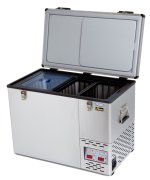jkidd
Active member
Just picked up a National Luna Twin 60 Freezer Fridge for a Four Wheel Camper that I have on order. I plan on using it in the C-Dory as well. This one is an inch wider and an inch taller and 5 inches longer than my Engel Mt-45. I had the Engel under the table. The new one needs to be mounted on a slide in the same spot. I ran my first test at 72 degrees ambient temp and the fridge was empty. I did this to get a bench mark. Ran it for 24 hours on a Oddesey Extreme group 31 and used a Victron 700 for the monitor. It used 17 amps for a average of .708 amps per hour. The next test will be to load both compartments wait for it to cycle and see what the next 24 hours bring.

Specifications
Item #3115
External Dimensions 30"L x 17"W x 21"H, 35.94" H with lid raised
Actual Volume Right Bin: 36.87 quart (40L) Left Bin: 25.57quart (20L)
Weight 62 lbs
Materials Rigidized 430 stainless steel exterior, smooth aluminum interior
Insulation 40mm thick, high density foam injected
Baskets Divided Freezer compartment with lid, 5 food grade plastic baskets included
Color Silver
Compressor Danfoss BD35F
Power supply 12 / 24V DC, 120V AC standard
Power consumption draw* 12V - 2.5 Amps average running current
Power Consumption range* 1.53 - 2.6 amp/hour average power draw
Average power consumption is measured in a controlled environment with specific thermostat settings. Actual power consumptions may vary considerably with ambient temperature, thermostat settings and frequency of use. Power consumption will increase during periods of surplus available power (Turbo mode)
Shipping Dims. 33"L x 20"W x 23"H

Specifications
Item #3115
External Dimensions 30"L x 17"W x 21"H, 35.94" H with lid raised
Actual Volume Right Bin: 36.87 quart (40L) Left Bin: 25.57quart (20L)
Weight 62 lbs
Materials Rigidized 430 stainless steel exterior, smooth aluminum interior
Insulation 40mm thick, high density foam injected
Baskets Divided Freezer compartment with lid, 5 food grade plastic baskets included
Color Silver
Compressor Danfoss BD35F
Power supply 12 / 24V DC, 120V AC standard
Power consumption draw* 12V - 2.5 Amps average running current
Power Consumption range* 1.53 - 2.6 amp/hour average power draw
Average power consumption is measured in a controlled environment with specific thermostat settings. Actual power consumptions may vary considerably with ambient temperature, thermostat settings and frequency of use. Power consumption will increase during periods of surplus available power (Turbo mode)
Shipping Dims. 33"L x 20"W x 23"H
